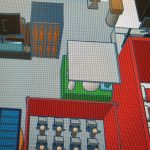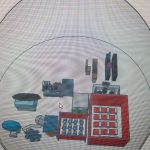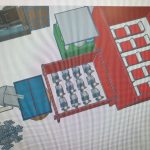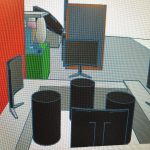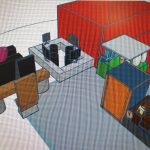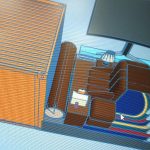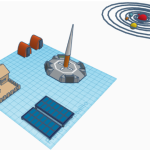ARIANE CAMP by MOONCAMPERS
Institut Martí i Franquès Tarragona-Catalonia Spain 16 years old 8 / 2 Català Moon
External link for Tinkercad 3D design
Project description
Com a emplaçament per situar la nostra base lunar vam decidir que el millor lloc seria el cràter Shackelton que té 4,2 km de profunditat i l’interior el qual està fosca permanentment. Mentre que l’exterior està il·luminat constantment. La millor forma per a la base és la forma de cúpula perquè és apte per suportar la radiació còsmica i possibles impactes de meteorits. Tenint en compte aquests dos factors la base triada per aquesta missió és la mateixa utilitzada en la missió Artemis 3. Que ofereix flexibilitat per als allunatges i diversifica els objectius de l’exploració espacial.
La base lunar constarà de quatre zones
- La base extractora de l’aigua subterrània
- Els habitatges i la zona de control
- La zona de creació d’aliment i oxigen
- Zona de generació d’energia solar
- Zona per a vehicles i fer missions lunars.
Per a energitzar la base farem ús d’energia de fusió nuclear (obtinguda amb l’extracció d’heli-3 de l’interior de la Lluna, acceleraríem els seus electrons per crear un plasma en un reactor Tokamak millorat amb les característiques anomenades en aquest mateix apartat, creant la famosa energia de fusió nuclear.) juntament amb energia fotovoltaica (la qual obtindrem amb els panels solars mencionats anteriorment).
En relació amb la protecció de la base farem servir dos sistemes de defensa.
El primer sistema de defensa es basa en canons de plasma i electromagnètics i el segon consisteix en canons de partícules superaccelerades que aconsegueixen la desintegració fins a la massa crítica.
Com a experiment vam simular la filtració de nuclis de gel lunar per a extreure aigua per tal de veure com aconseguirem aigua en l’entorn lunar. En aquest experiment vam crear els nuclis de gel lunar (aigua amb sorra que vam congelar) i la vam filtrar per tal de comprovar la potabilització de l’aigua.
Project link
https://docs.google.com/document/d/1fYRA_0WiMpl80MnAEd9njbiusFHne3aa04pNqFTg_Kc/edit?usp=sharing
English translation
As a site for our lunar base we decided that the best place would be Shackelton Crater which is 4.2 km deep and whose interior is permanently dark. While the outside is constantly lit. The best shape for the base is the dome shape because it is able to withstand cosmic radiation and possible meteorite impacts. Considering these two factors, the base chosen for this mission is the same one used in the Artemis 3 mission. It offers flexibility for departures and diversifies the objectives of space exploration.
The lunar base will consist of four zones
The extraction base of the underground water
The homes and the control area
The area of creation of food and oxygen
Solar energy generation area
Zone for vehicles and do lunar missions.
To power the base we will use nuclear fusion energy (obtained by extracting helium-3 from the interior of the Moon, we would accelerate its electrons to create a plasma in an improved Tokamak reactor with the characteristics called in this same section, creating the famous nuclear fusion energy.) together with photovoltaic energy (which we will obtain with the solar panels mentioned above).
In relation to the protection of the base we will use two defense systems.
The first defense system is based on plasma and electromagnetic cannons and the second consists of super-accelerated particle cannons that achieve disintegration up to critical mass.
As an experiment we simulated the filtration of lunar ice cores to extract water in order to see how we would get water in the lunar environment. In this experiment we created lunar ice cores (water with sand that we froze) and filtered it in order to test the potability of the water.
#3D Design #Scientific Experiments #Other
Other Projects







